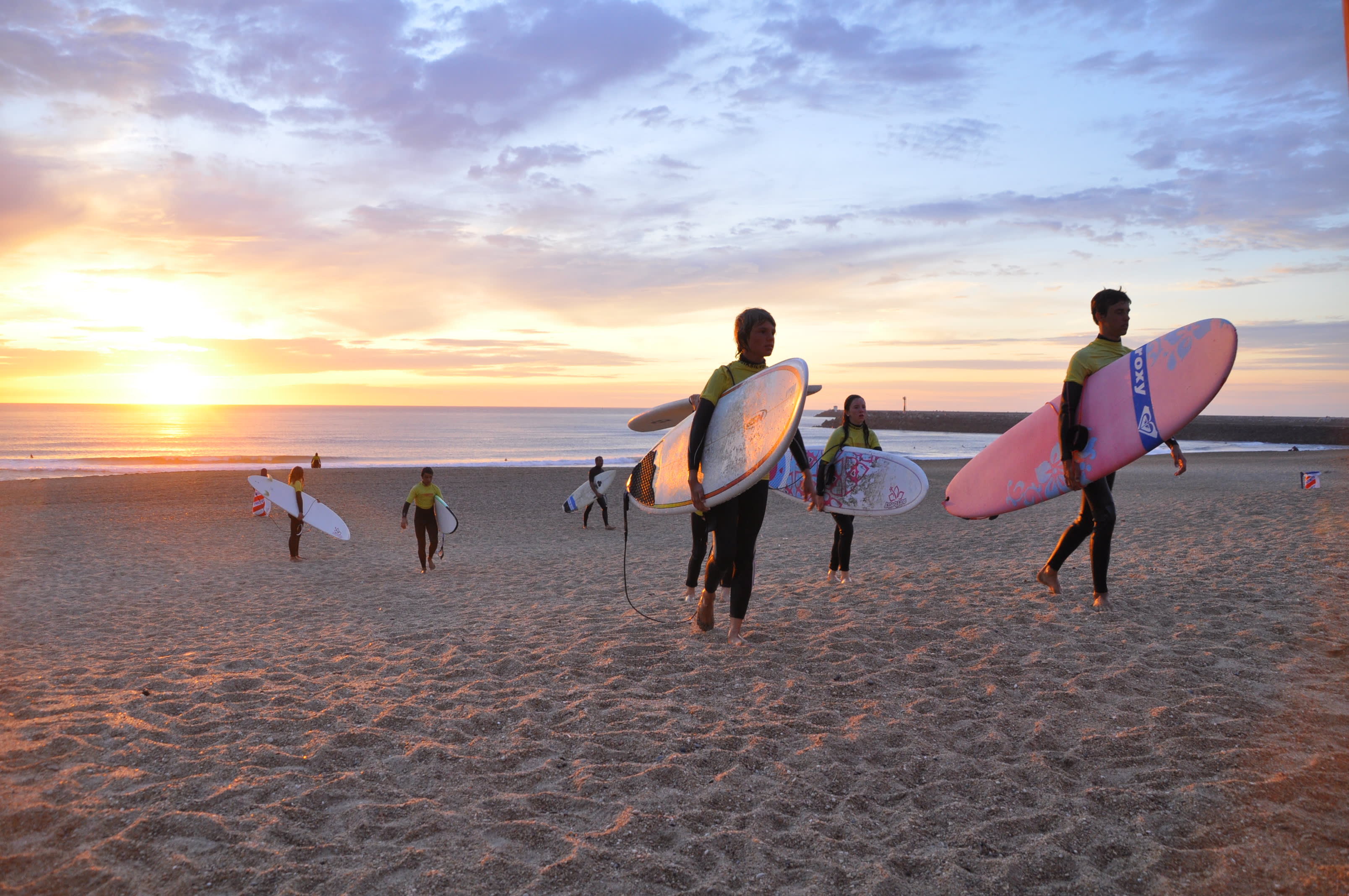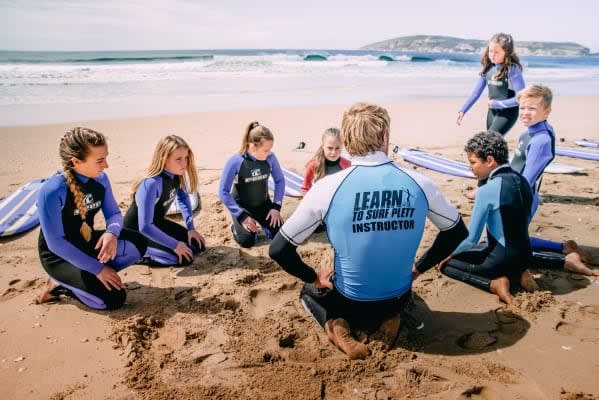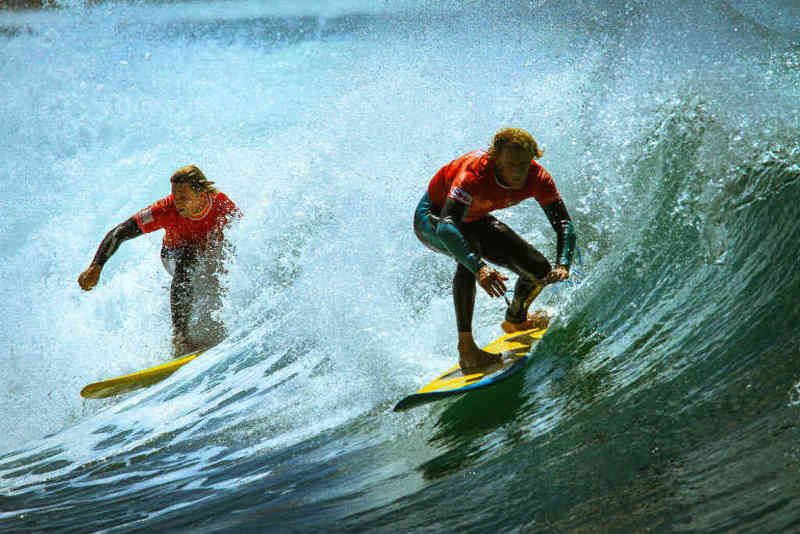
Surfing expressions you need to know
Discover the expressions of surfing, between wave types and surfer figures, and familiarise yourself with the world of hectic marine adventures...

Before embarking on your first surf lesson and riding your first wave, it's essential to know a few basic tips to ensure a safe and enjoyable experience. Familiarise yourself with the rules on equipment, safety and much more.
One of the coolest and most fun ocean sports to try is definitely surfing. It may look easy to cruise elegantly on the waves, but you’ll quickly learn it’s anything but.
Rome wasn’t built in a day, and these cool and carefree surfers all started out in the same way as you. With these tips and tricks, you’ll be able to spend more time on the board riding than in the water wiping out. And to put the following tips into practise afterwards, book a first surf lesson at one of the best spots to go surfing for beginners.
Just as there's no smoke without fire, there'll never be any surfing without prior knowledge of swimming and the aquatic environment! If you're scared of water or don't feel comfortable in it, we strongly advise you to give up the fantasy of surfing, whatever it takes. We tend to come up with unfounded certainties such as: "surfers have boards to float on, don't they?" ...well no, spoiler alert, the board won't always be by your side during a session!
Just imagine for a second that your leash (the rope connecting the tail of the board to the surfer's leg) breaks or becomes detached... this is just one example, but there will be many cases where you'll have to manage without this accessory. So, first and foremost, you need to be able to swim well, because unfortunately, breaststroke won't help you in the face of currents and waves!
Another tip in this list of the things to know before your first surfing lesson is breath control. A good surfer knows how to swim and is also skilled at holding their breath underwater. It’s inevitable that you find yourself under the waves after a wipe-out. For example, when you don’t make your pop-up, the force of the waves can push you under. Many compare it to being in a washing machine on spin mode! It can be pretty disorientating, but it’s important not to panic, and to let the water move you until the wave passes.
This is where holding your breath comes in. Try to take a deep breath before paddling onto a wave (or if you suspect you’re about to be pulled under) so you’ll have enough oxygen. This is normal and part of the learning process! You’ll only end up underwater for a few seconds, so learn to relax and embrace it. Worst case scenario, you may have to wait for two waves if the sets are very close together. At most, you’ll only spend 30 seconds under the breaking waves, so just stay zen and you’ll pop back up before you know it!
Surfing involves choosing the right locations and weather conditions for your skill level. In order to do this successfully, you’ll need to understand how tides affect a spot, the strength of a swell, and the size of the waves.
Surfing locations considered either a point break, a reef break, or a beach break. If you are just starting out, the best kind of spot to choose is a point break. The waves here move slower and are more gentle. Beach breaks often break harder and steeper, and reef breaks are just above submerged coral or rocks. When you wipeout (which is inevitable for everyone), hitting the reef is very painful. If you feel lost with all these specific terms, the most common surf expressions and vocabulary will be helpful.
Tides are important as well when it comes to picking a spot. Check the tide times and the size of the swell before you go. You will find that where one day there can be 2-meter waves, another day at the same spot the waves are only 50 cm. You can check out this information on several sites such as Windguru or Magicseaweed.
If you aren’t sure still after checking these websites and you want to know if it’s the right time to surf, look at the line-up and if it is empty. If so, it’s probably because the conditions aren’t favorable, e.g too much wind or current or not enough swell. Alternatively, don’t hesitate to ask the local surf shop, they’ll tell you everything about the tide times and when to go surfing.

One of the most important of the 12 things to know before your first surfing lesson is to never surf alone. Make sure to always paddle out with a friend. This should be someone who knows how to swim. Also, pick a surf spot where there are lifeguards towers nearby. In the event of a fall or injury, you may need assistance to get back to shore safely.
A potentially dangerous scenario you could encounter involves what is called a riptide. If a surfer becomes tired and finds themselves stuck in a rip current, they can be pulled out to sea. The best technique to escape a riptide is to let yourself be carried by the current without resisting, while simultaneously making efforts to attract the attention of lifeguards or other surfers in the line-up. You can also try swimming into the beach diagonally, rather than straight towards it.
One thing is for sure, the ocean can be dangerous, and you should never underestimate the power of the elements. We use the saying, “when in doubt, don’t paddle out”, to assess the situation.
Before you try surfing, it’s important to acknowledge the power of the ocean. The waves are a force to be reckoned with and winning against this massive powerhouse is unlikely.
But luckily, the ocean accepts that we like to play in it - as long as we do so with respect. Learning to surf teaches you how to analyze and understand your surroundings. No two waves are the same, so you have to constantly be able to adapt to the ocean’s changing conditions.
Surfing is not simply another sport, it demands humility and patience with mother nature. After all, the waves will always have the last word!
Another factor to consider on the list of things to know before your first surfing lesson is the right board and wetsuit. These can have an impact on how quickly you learn to surf. You will want to choose the right length, width, and weight. For example, if your surfboard is too small or light for your specific weight, it won’t keep you afloat.
It’s also important to pick the right style of the board for your skill level. When you are learning, the best choice is a longboard. Beginners will have a very tough time trying to stand up on high-performance shortboards. They may look cool, but they are for advanced surfers who can stand up on waves in their sleep.
If you’re reading this article, you are likely new to surfing. Ideally, you’ll want a board that’s around 8-feet, preferably made from foam, epoxy, or plastic materials. The more you advance, the shorter you can go with your board. Shortboards are simply not very buoyant and require refined technique and expertise to master. If you start surfing with a small board, then you’ll quickly end up discouraged and all the fun during your first session will be lost.
When it comes to wetsuits it’s just as important what you pick. Choose the right thickness (3/2mm, 4/3mm, 5/4mm…), according to the water temperature. The fit should tight so that water isn’t coming in. In winter, opt for booties, gloves, and a hood if you want to last more than fifteen minutes in the frozen water!
You will definitely want to wax your board before paddling out. Consider the water temperature when choosing your wax type. If you start rubbing cold water wax on your board in warm water you’ll feel it melting before you even get in the sea.
Once you’ve bought the right wax (it says on the packets which temperature you can use it in) then layer up the wax in places where your feet will be and even your hands, this will give you some extra stability in your pop-ups.
While you might not see everyone warming up, it is a very good idea to prepare the body for the physical effort you’ll be putting it under. Some good stretches and exercises to open the hips and shoulders, a bit of a quick jog on the beach, and you’ll be good to go.
Just as importantly, don’t forget to drink water and hydrate yourself before the session, it is essential to your performance as you’ll probably spend at least two hours in the sun while expending a lot of energy. Speaking of the sun, make sure you sun cream up to avoid a nasty sunburn!
Prior to your first paddle out, you will want to spend some time practicing the pop-up, or take-off technique on dry land. Practice positioning yourself lying down on the board. Line your toes up on the back end of the board with your chest pressed firmly down. Check to see if you are “regular” or “goofy” footed. This refers to which foot you naturally place forward on any kind of board you may ride.
Once you’re actually in the water, you’ll want to paddle as hard as you can, while keeping steady on the board. After one or two seconds, attempt to pop-up. At the same time, you’ll raise yourself up by pushing on your hands which remain in line with your chest. Then, straighten up by sliding your legs forward under the body. Lean on your foot and try not to put your knee on the board (this creates a lot of instability).
Once you’ve successfully stood up, use your arms for balance, and to help you turn and change direction. Also, be aware that the direction you look will dictate where you go, so don’t look down at your feet! You will end up nosediving soon if you do! The more you practice this both in and out of the water, the more natural it will become.
Another important tip is to learn to surf where it is most appropriate. For example, you should avoid learning to surf in a designated swimming area. Children often swim and play here, so you will want to avoid this area, in case your board goes flying.
Surfing is very much its own culture, and there are rules in which someone must learn to behave. For instance, being polite and courteous, saying hello, and apologizing if you cut another surfer off. The rules are similar to being in a car and obeying the rules of the road.
There is also the issue of priority. You may have noticed that there are many surfers in the water. Surfers who are waiting for a wave are in what is called “the line up”. Only one of them will have the priority of surfing the incoming wave, and this is the person who is closest to where it breaks. If that’s not you then you must respect the other surfer. Check carefully to see in which direction the wave breaks, either left or right. If there isn’t a surfer already on it, you can paddle for it.
Another unspoken rule is that locals have priority. Surfers are very territorial, and they don’t like tourists taking their waves. Therefore, it’s always a good idea to let the locals have extra priority.
Now that you’re armed with these rules to know before your first surfing lesson, we wish you good luck. Remember, the important thing is to have fun! Do not panic if you aren’t resembling Kelly Slater your first time. Keep in mind everyone learns at their own pace.
Check out all of our surfing activities to book your first surfing lesson! The ocean is waiting for you!